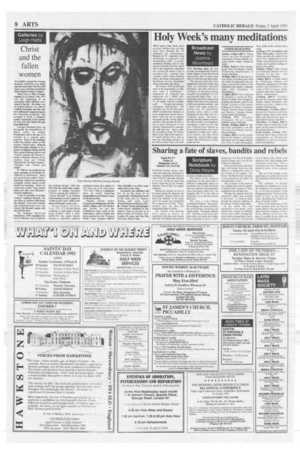Page 8, 2nd April 1993
Page 8

Report an error
Noticed an error on this page?If you've noticed an error in this article please click here to report it.
Tags
Share
Related articles
Book Without Words
Sixties Style, Nineties Nonchalance
A Sun Kissed Son Of Liverpool
Art Historians At The Touch Of A Screen
'tomorrow Will Be Beautiful'
Galleries by Leigh Hatts
Christ and the fallen women
WALKING around the Georges Rouault exhibition you might gain the impression that the artist spent years painting prostitutes before finally turning to religion.
This is not so. Baby Georges' baptism on St James's Day 1871 was the beginning of an association which affected every aspect of his life. His father was an ardent follower of a liberal Catholic theologian and this may have influenced young Georges in his Christian socialism. His attempt to form a religious artists' community in the manner of Eric Gill only failed through legal difficulties.
Georges Rouault grew up alongside the foundations of Sacre Coeur in artistic Montmartre and at the age of 16 worked as a stained glass restorer. Some of his paintings reflect the sombre colour of 19th century Church glass. Rouault believed artistic emotion to be a source of religious feeling and his first award-wiruting picture was "Christ Among the Doctors". Other religious themes of his student years are "Christ Mourned by the Holy Women", "Salome" and "Christ and Judas".
By 1904 he was producing his many paintings of prostitutes for which he is well known. There are several just called "Girls" depicting voluptuous unsmiling youngish women naked except maybe for stockings. These are venerated rather than pitied ladies, for they were Rouault's Parisian neighbours.
"I am no specialist in brothel women," explained Rouault. He saw them as isolated individuals like himself. Even more isolated and misunderstood were the clowns who Rouault caught with sad. off-duty faces.
The catalogue (RA/Lund Humphries; £9.95) highlights the circus influence and recognises the Catholic thread. After the 1914 War the earlier line of girls, accused or judges becomes "Christ among the Soldiers". "Christ Mocked" is an isolated Christ lacking even the support in "Christ on the Cross" which is the climax of RouenIt's early years,
Georges Rouault: The Early Years 1903-1920 at the Royal Academy is open daily (except Good Friday) until 6 June (£4/£2.70) but until Easter Tuesday a specially reduced combined ticket also admits to The Great Age of the Watercolour 1750-1880. This is a delightful show of works featuring topographical and intimate scenes by the great artists.
Thomas Girton makes Morpeth and Bridgnorth look like Italian villages and with Rooker and Turner we see the Lindisfarne ruins, cattle in the Glastonbury Abbot's kitchen and sheep penned by the "Ewenny Priory" rood. Cotmanis 1802 St Mary Redcliffe is cut off by water rather thane busy road.
Fortunately the exhibition will live on in the form of an exceptionally well-illustrated book of the same title by Andrew Wilton and Anne Lyles (Prestelaharnes & Hudson; £39).
• Catholic Herald photographer Carlos Reyes' exhibition In The Infinite Time of Dreams is at Bolivar Hall, 54 Grafton Way, London Wl, today and Mon-Thu next week, 10am to 7pm.
blog comments powered by Disqus











